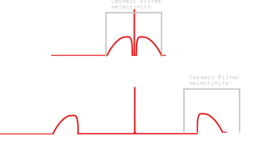neazoi
Advanced Member level 6

Ok my idea goes like this:
A superhet receiver that does use a simple ceramic filter in the 455KHz IF, but instead of selecting the IF (plus USB, minus LSB), to select the IF+30KHz with a single ceramic filter. This will select 2 sidebands that are +30KHz and -30KHz away from 455KHz instead of close to it.
One of these sidebands (say LSB) can be easily filtered then by this single ceramic filter. After filtering and detection, this will leave you with a +30KHz (plus 3KHZ for the audio range) USB detected audio. Now what you want is to shift this 30KHz (plus 3KHZ for the audio range) audio down to 0-3KHz. At that point you re-introduce a sideband, but this is now at audio. And you can make a steep audio filter relatively easily.
The reverse procedure can be used for transmission.
How do you find my idea?
A superhet receiver that does use a simple ceramic filter in the 455KHz IF, but instead of selecting the IF (plus USB, minus LSB), to select the IF+30KHz with a single ceramic filter. This will select 2 sidebands that are +30KHz and -30KHz away from 455KHz instead of close to it.
One of these sidebands (say LSB) can be easily filtered then by this single ceramic filter. After filtering and detection, this will leave you with a +30KHz (plus 3KHZ for the audio range) USB detected audio. Now what you want is to shift this 30KHz (plus 3KHZ for the audio range) audio down to 0-3KHz. At that point you re-introduce a sideband, but this is now at audio. And you can make a steep audio filter relatively easily.
The reverse procedure can be used for transmission.
How do you find my idea?

